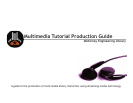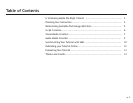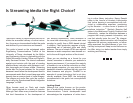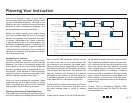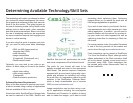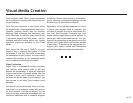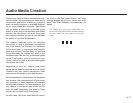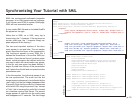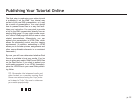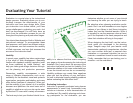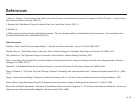
p. 2
p. 2 p. 3
Is Streaming Media the Right Choice?
There are a variety of media formats that can fa-
cilitate the successful delivery of online instruc-
tion; the one you choose should reect the goals
and abilities of your instructors and learners.
This guide is based on the redesigned online
Engineering Communications Tutorial at the
University of Texas, developed by the McKin-
ney Engineering Library in partnership with the
Digital Information Literacy Ofce and Digital Li-
brary Services Division. The tutorial underwent
analysis and revision with the goal of creating
effective library instruction with guidance in mul-
tiple languages and diverse media. Streaming
media was the format selected for the project
because it would allow the development team to
use separate audio les for each language while
drawing from a common bank of visual imagery.
The images and audio les could be synchro-
nized using the Synchronized Media Integration
Language, or SMIL.
Other formats—such as Flash and simple
HTML—were rejected for a variety of reasons.
Although Flash offers many interactive features
that lend themselves to the development of
rich learning experiences, Flash animation is
far more time-consuming to produce and more
complex to modify than a SMIL-based tutorial.
In addition, Flash production requires a highly-
specialized set of technical skills and costly
software. The use of simple HTML was rejected
because an audio component was deemed cru-
cial to the multi-lingual sections of the tutorial.
When you are deciding on a format for your
tutorial, remember to consider your audience’s
learning environment. If you expect the majority
of learners to use a dial-up connection or older,
lower-speed computers, you may wish to avoid
bandwidth-intensive solutions that rely upon the
latest browsers and plug-ins. FlashMX is an
example of current technology that is not ubiq-
uitously available. Even SMIL, the technology
recommended in this guide, has cross-platform
limitations.
Looking Ahead
Although this guide focuses on the produc-
tion of audio/visual elements, the Engineering
Communications Tutorial development team
acknowledges the importance of active learn-
ing in online library instruction. Nancy Dewald
notes in the Journal of Acadmic Librarianship
that “active learning is accomplished with indi-
vidual or collaborative exercises, questioning
by the librarian... or other forms of practice to
reinforce instruction.”
1
Similarly, Brandon Hall
states in the Web-based Training Cookbook that
“Interactivity makes the difference between a
program that simply presents information, and
one that actually trains the user.
2
By integrat-
ing streaming media instruction with interactive
segments like quizzes, assignments, or follow-
along exercises, the effectiveness of your tuto-
rial may be improved. Keep in mind that even on
the Web, doing is a better teacher than simply
watching and listening.



